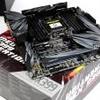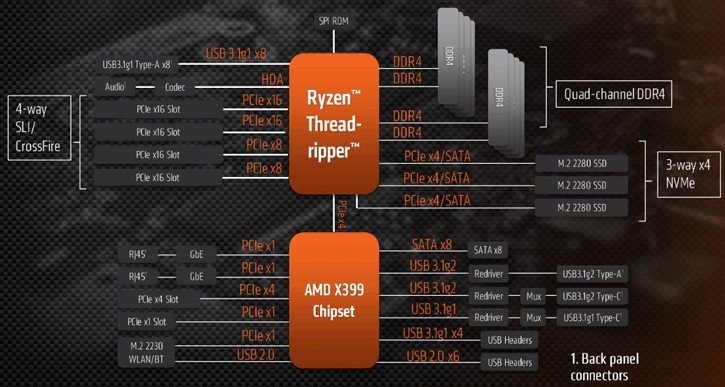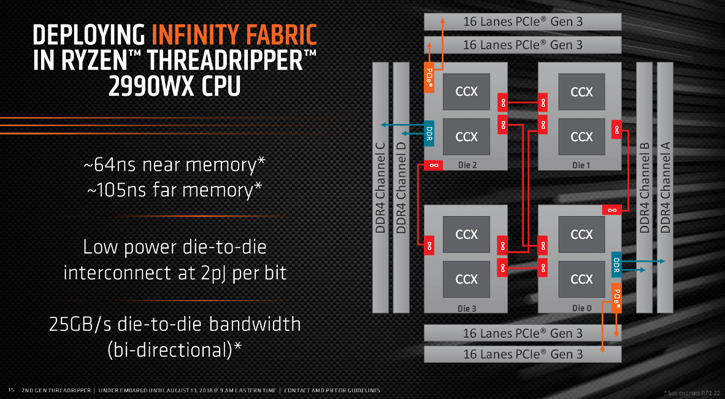The AMD X399 Chipset and Quad Channel memory
Threadripper Pinnacle Ridge Die
Being part of the Ryzen family, Threadripper processors are just that; CPUs based upon Ryzen architecture. While a lot of IO changes have been made to facilitate it, basically on-die you'll spot up-to four 8-core Ryzen processors, much like the Ryzen 7 2700X has two CCxes, each with four cores. When we go all the way back to one CCX, each of them have 4-cores enabled. For the twelve-core parts that means per 4-core cluster (CCX), one core is disabled and that means these processors are set up in a 3+3+3+3 (6+6) fashion. Other than that, again, these are physically similar to the 8-core Ryzen design, it is the very same die that is used, however, binned for high performance. Last year's eight-core ZEN architecture was called 'Summit Ridge', the updated revision 12nm Zen+ series dies got the development name 'Pinnacle Ridge'. In April 2018, AMD now launches new SKUs in the Ryzen 2000 series. Among them the Ryzen 7 2700 and 2700X. The 2000 numbering in the series is obviously a euphemism and recognition point for generation 2 of the Zen architecture-based processors, now called Zen+. AMD is using the top 5% of binned ASICs. So as the 8-core Ryzen die is similar, that also means and invokes corresponding caches. And before you ask, yes, Threadripper processors are all SMT threaded (the acronym is Hyper-threading) and yes, you get that sweet unlocked multiplier as well. The Ryzen Threadripper series up-to 16 cores have a 180W TDP and up-to 32 cores, a 250 Watt TDP.
The Ryzen Processor Family
On the market you will spot Ryzen series 3, 5, 7 and now Threadripper processors. It’s plain and simple and, as always, that works out the best to understand product positioning compared to the Intel line-up. We’ll go into more detail on the next few pages, of course.
Unlocked & loaded
Let me again make it clear, all Threadripper processors are unlocked. The motherboards need a chipset that is unlocked as well though, but the X399 are covering all of that. Be warned though, all-core overclocks on so many cores, let's just say we advise to stick to proper water-cooling and let XFR2 do its thing. None the less we'll look into a bit of tweaking later on in this article of course.
Precision Boost 2 and XFR2
The X and WX models are a little more special in the sense that they will have a higher base and boost clock frequency as well as extended frequency range (XFR). Basically, you have precision boost, your standard turbos that each of the cores can handle. However, on top of that is XFR, if the processor is under optimal conditions like (for example) liquid cooling, it may clock a bit higher than your maximum turbo clock frequency. It isn't just temperatures though, X model processors are binned. This means that the processors are tested on ASIC quality and then sorted from good to better and often will clock higher on the XFR range and yes, X models could also be more easy to tweak as well. ZEN+ based CPUs will feature Precision Boost 2 and XFR 2, both are improved to offer better performance, specifically in tasks that have several light threads, games for example! You all know what the media has written about 1080p performance last year. This is such an example where AMD could benefit from XFR2. Intel has had the lead in some game titles, mostly due to higher frequencies with its CPUs. Precision Boost 2 should help Ryzen processors to perform better in tasks that have several light threads, such as games. XFR2 is now available on all CPU cores, rewarding you with up to 15% more boost performance.
The X399 Chipset
Here things remain the same. Aside from a mandatory BIOS update, you're good to go. There will be some new motherboards launched, and with ASUS Zenith, if you plan to overclock the 32-core part, please opt the now optional VRM cooler kit. While some of the chipset functionality is harbored inside the processor, a new generation and architecture processor will always require a new motherboard chipset. Let me first reiterate and make clear that ALL Ryzen processors are unlocked, that entails all Ryzen 3, 5, 7 and thus now the new Threadripper processors. Threadripper processors however will require a new socket due to the many pins needed. The platform will be using Socket design SP3r2, a 4094-pin socket that was originally developed for the AMD Naples (EPYC) series server processors, but again, AMD did a 180 and is introducing it also as high-end desktop platform series processors and chipsets.
The processing power that Threadripper offers is balanced by more memory bandwidth via quad DDR4 channels, and it’s backed by up to a whopping uncompromising 64 PCIe 3.0 lanes for things like multiple graphics cards, many ultra-fast NVMe SSDs and fast USB and Ethernet. Threadripper ready motherboards will come with 8x DDR4 DIMM modules that can hold a total of 128 GB of DDR4 memory and you will often see 4x PCIe x16 slots and support for up to three NVMe M.2 drives on these motherboards as, well, the motherboard manufacturers have enough PCIe 3.0 lanes to work with. PCI-Express Gen 3.0 is fully supported on all 64 PCIe Lanes, that means you also get full support for the NVMe protocol, USB 3.1 Gen 2 (10 Gbps) and M.2 and SATA Express support. Since Ryzen architecture processors have all the IO paths and a controller built in for USB 3.1 (Gen 2) as well there will be PCI lanes dedicated to your NVMe needs.
The X399 chipset will support multi-GPU rendering (Crossfire and SLI) with up-to four mechanical x16 PCI Express slots (Gen 3.0) and connected from there onwards endless possibilities in your configuration, say, 16x/16x/8x/8x Gen 3.0. The Ryzen Threadripper processor has an I/O of 64 PCIe 3.0 lanes. The interlink between the Threadripper processor and X399 chipset is a 4x PCIE Gen 3 link - and then your X399 chipset will also offer additional 20 (!) PCIe Gen 2 lanes and 12 (!) SATA3 ports. Again, four lanes function as an interconnect to the chipset. In the above screenshot, you can check how that works out compared to Ryzen / X370.
Quad channel DDR4 Memory
AMD brought DDR4 support to Ryzen 3 5 and 7, but that remained dual-channel. With Threadripper that quad-channel support is being introduced. The motherboards will be paired with eight DIMM slots, configurable as single, dual and quad channel setup. AMD will support the standard Jedec SPD timings and frequencies at 2133/2400 and 2667 MHz, but you can expect to see motherboards with support for 3200/3466 MHz (and higher up-to 3600 MHz) as well.
With everything that is going on with Threadripper you already know that the physical size and layout of the processor is big. That also means some DIMM DDR4 channels are closer, while others are farther away from the memory controllers. You could describe that as near memory and perhaps far memory based on the distance of the two processor chips and its cores inside the package. Near memory has a latency in the 77ns range while far memory can pass 120ns. AMD’s solution typically is to use Ryzen select (in BIOS or Ryzen Master) two memory modes that. UMA is the Distributed Mode memory control - it is the platform default and allows software to use all the DRAM evenly. Local Mode NUMA uses local memory near the die or chip to gain lower 66.2ns latency. Obviously, the number of modules of memory installed is trivial here, but we assume most end-users will use 4 DIMMs in quad-channel.
Generally, older/less threaded games might run slightly faster in the Local mode while latest games/heavily threaded games (e.g. Ashes) will run better with the default Distributed mode. Very simply put, Distributed mode offers better bandwidth, Local mode offers lower latency. Our advice, play around with it a bit and run both modes to get the complete picture and select your preference. We can see Gamers end up at Local mode and, say, video editors at the default Distributed mode.






